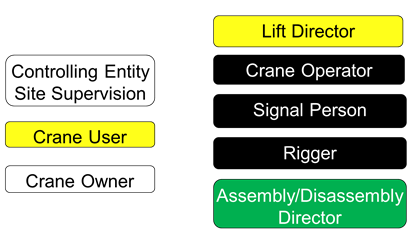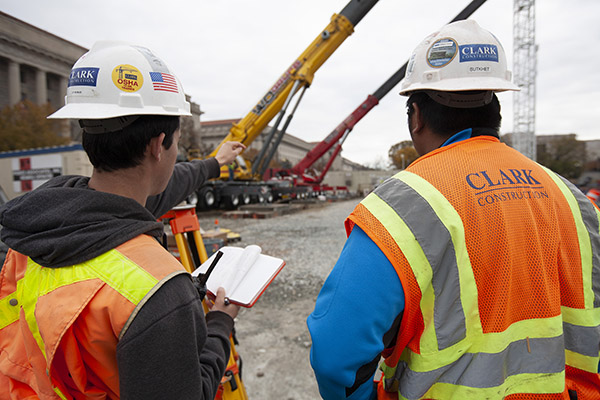Second in a series of related articles reviewing each of the roles that have been identified when working with cranes, explaining the responsibilities, defining the training requirements, as well as outlining the documentation requirements.
May 2021— As outlined in the first article in this series, the roles on the left side of the graphic do not have any requirements listed for qualification by OSHA or ASME (e.g., competent, certified, or qualified). However, they do have substantial areas of responsibility that are important to know and understand on the worksite.
As outlined in the first article in this series, the roles on the left side of the graphic do not have any requirements listed for qualification by OSHA or ASME (e.g., competent, certified, or qualified). However, they do have substantial areas of responsibility that are important to know and understand on the worksite.
OSHA defines Controlling Entity as an employer that is a prime contractor, general contractor, construction manager or any other legal entity which has the overall responsibility for the construction of the project—its planning, quality and completion” (1926.1401).
ASME defines Site Supervision as a role that “exercises supervisory control over the work site on which a crane is being used and over the work that is being performed on that site” (B30.5-3.1.3(c)).
The Site Supervisor is responsible for:
- Ensuring the crane is inspected and in good condition
- Determining whether additional regulations/requirements are applicable
- Ensuring a qualified person is designated as the Lift Director
- Ensuring crane operations are coordinated with other jobsite activities
- Ensuring that the area for the crane is adequately prepared (access, room, suitable ground, traffic control)
- Ensuring Assembly/Disassembly is supervised by a qualified person
- Ensuring crane operators meet the requirements
- Ensuring conditions that may adversely affect crane operations are addressed
- Allowing crane operations near powerlines only when requirements are met
- Defining special lifting operations protocol
- Ensuring the rigging crew is supervised by a qualified person
- Ensuring crane maintenance is performed
Typically, when these responsibilities are outlined, Site Supervisors/Controlling Entities balk at the extent to which they are expected to be involved in the crane operations. However, their role is critical. They need to set the rules of engagement and ensure that the rules are being followed. Site Supervisors/Controlling Entities also have control over the site and the individuals/entities working there. They are the most knowledgeable regarding ground conditions as well as workflow and crew requirements. These elements become even more significant when space on the worksite is limited or site conditions are poor.
It also is significant that the Lift Director is designated by the Site Supervisor. The Lift Director is a key individual in implementing the plan. Therefore, it is important that they have direct access to those who are responsible for creating the rules of engagement (Site Supervisor/Controlling Entity). Lift Directors are easy to discern. A Compliance Officer only has to ask the rigger or the signal person who the Lift Director is. If the answers aren’t consistent, or they don’t know, the Site Supervisor can be held responsible for not making the roles and responsibilities clear.
Crane User is a term that only ASME utilizes. ASME defines the Crane User role as the one who “arranges the crane’s presence on a worksite and controls its use there.” In today’s construction sites, this is the most overlooked role and one that should be specifically assigned.
The Crane User is responsible for:
- Complying with regulations, standards, and manufacturer’s requirements
- Using supervisors that are qualified for crane activities
- Ensuring the crane is in proper operating condition, including verifying the crane owner has provided the required documentation and frequent inspections have been completed
- Verifying that the crane has the necessary lifting capacity to perform the work
- Using crane operators that meet the requirements
- Ensuring the assigned operator(s) have been notified of adjustments or repairs that have not yet been completed
- Designating personnel for maintenance, repair, transport, assembly and disassembly
- Ensuring all inspection, testing and maintenance programs specified are followed
- Informing the crane owner if rope on the crane is replaced or shortened
Two things become evident from the lists of responsibilities. First, on smaller jobsites, the Crane User role is typically included with another role such as Site Supervisor, Lift Director, etc. Second, overlapping of responsibilities becomes obvious. While the responsibilities overlap, the perspectives the roles are coming from can be different. When ASME puts responsibilities under multiple areas, it is in order to have a full perspective and to ensure that these significant items are not missed.

The Crane Owner, Crane User, and Site Supervisor each come from a different perspective, so they must understand exactly what their responsibilities are.
Lastly, we have Crane Owner. According to ASME, the Crane Owner “has custodial control of a crane by virtue of lease or ownership.” ASME was careful to keep the roles and responsibilities within the four corners of the worksite. If a rental crane with operator comes into the site, then the crane is typically “owned” by the crane supplier. On the other hand, in the event a crane is bare rented, the owner is the entity on site that is renting the crane (not the crane rental company). It is important for companies who bare rent to understand the crane owner responsibilities rest on them.
The Crane Owner is responsible for:
- Providing a crane that meets the requirements of the standards and the Crane User
- Providing a crane and all components specified by the manufacturer to meet the Crane User’s requested configuration and capacity
- Providing additional technical information when requested by the Crane User
- Providing assembly/disassembly, operation, maintenance and warning decals
- Establishing an inspection, testing and maintenance program
- Designating personnel for maintenance, repair, transport, assembly and disassembly
- Maintaining rope information for the rope installed on each drum
Crane Owners have a say in who the personnel are for maintenance, repair, transport, assembly and disassembly, as does the Crane User. This is due to the fact that disassembly occurs on the site, but the components and equipment leave the site.
Most importantly, Crane Owners should be a technical resource on the equipment. So, if you bare rent a crane, do you have the technical resources to answer the questions that may arise? If not, you should seek to put these in place as part of your bare rental considerations.
If you missed the first article in this series, you can catch up here.
By Thom Sicklesteel, CEO of the National Commission for the Certification of Crane Operators (NCCCO), a voting member of ASME B30.5, and an alternate on B30.
View the other articles in this series: